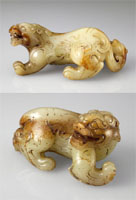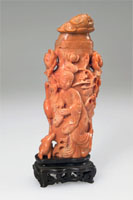 |
| Boulder with Mountain Scenes: Two Deer on a Path, the other side shows the God of Longevity with an Assistant, Qing dynasty (1644 – 1911), late 18th – early 19th century, nephrite, gift of Maria and John Dirlam, 1997.137 |
March 4, 2006 – June 17, 2007
Tough and alluring, jade (both nephrite and jadeite) has fascinated Chinese artisans and connoisseurs for thousands of years, becoming inextricably connected with Chinese culture. Perceived as a stone of supernatural and spiritual powers, jade became associated with rituals, magic and immortality. Its hardness, luster, sharp yet smooth edges, rich colors and translucency were likened to Confucian virtues, such as, intellectual acuteness, purity, fair-mindedness, loyalty and honesty. Taoists called their supreme being “The Jade Emperor” and believed that in paradise palaces were made of jade.
Over 90 objects of varied functions and symbolism are included in the exhibition. From Neolithic times onward, jade boulders harvested from riverbeds in mountainous regions were laboriously sawed, ground, drilled and polished. Artisans created ceremonial objects, magical pendants to preserve the dead and protect the living, sculptures of mythological beasts and elegant scholar-desk items. During the Qing dynasty (1644-1911), especially the reign of Emperor Qianlong (1736-95), imperial patronage, and the commissions of wealthy officials and merchants, spurred the creation of luxurious vessels and sculptures of human figures, flowers and animals. As is shown in the exhibition, jade artisans also produced exquisite works in other materials: amber, agate, amethyst, carnelian, coral, lapis lazuli, malachite, quartz and turquoise. Skilled contemporary jade-carvers continue to create spectacular works, often using modern power tools.
The jade collection at the Worcester Art Museum has mainly been formed through the generosity of Harry W. Goddard (1863-1927) and his wife Grace (1866-1935), and Maria and John Dirlam. The Dirlams have also loaned works from their private collection to the exhibition. The exhibition is further enhanced by rare ancient jades on loan from the collections of Drs. Ann and Robert Walzer and the Rubin – Ladd Foundation, Ester R. Portnow Collection of Asian Art.
Click here to learn more about a few select works from the Museum's Permanent Collections that are featured in the Mountain Harvests exhibition.
Generous support provided by the Dirlam-Morris Charitable Trust and Maria and John Dirlam.
Related Events
Lecture: Images of Jade in Early China
Saturday, April 15, 2PM
In the Analects of Confucius, one of Confucius' disciples asks the master what he should do with a beautiful piece of jade: wrap it up and keep it in a box or sell it for the best price possible. Confucius replies: “Sell it! Most certainly sell it! I myself am one who is waiting for an offer.” If Confucius can thus identify the “treasure” of his wisdom with jade, it is because jade in Chinese culture occupies the place of gold in Western culture. The most precious of stones, it is endowed with the highest moral virtues, and in religious Taoism paradise itself is called the Jade Capital. By examining the passages in which jade is mentioned in Confucian Classics and Taoist scriptures, this talk will explain how jade was perceived and what kind of virtues it represented in Ancient China. This lecture will be led by Dr. John Lagerwey, a specialist in Taoist ritual and Chinese village religion. Free with Museum admission.
| Select Images from the Exhibition | ||

|

|

|

| 
| 
|

|

|

 Sign up for WAM eNews
Sign up for WAM eNews